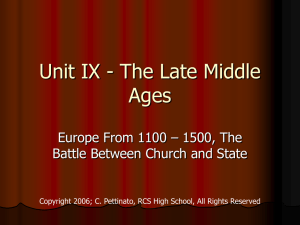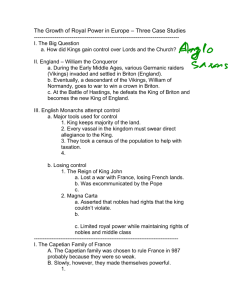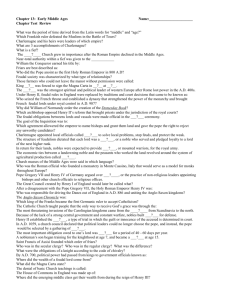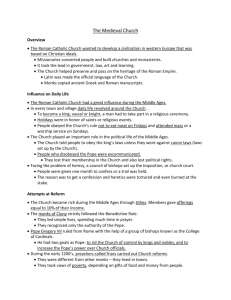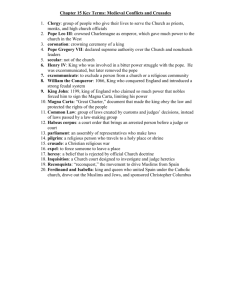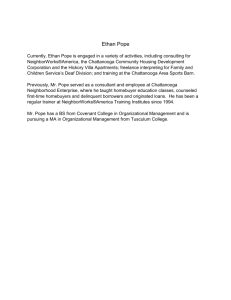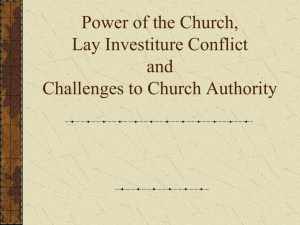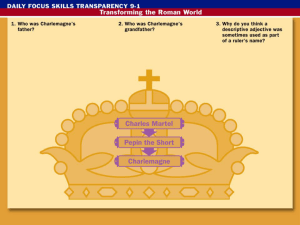Chapter 9 - Class Notes - Germantown School District
advertisement
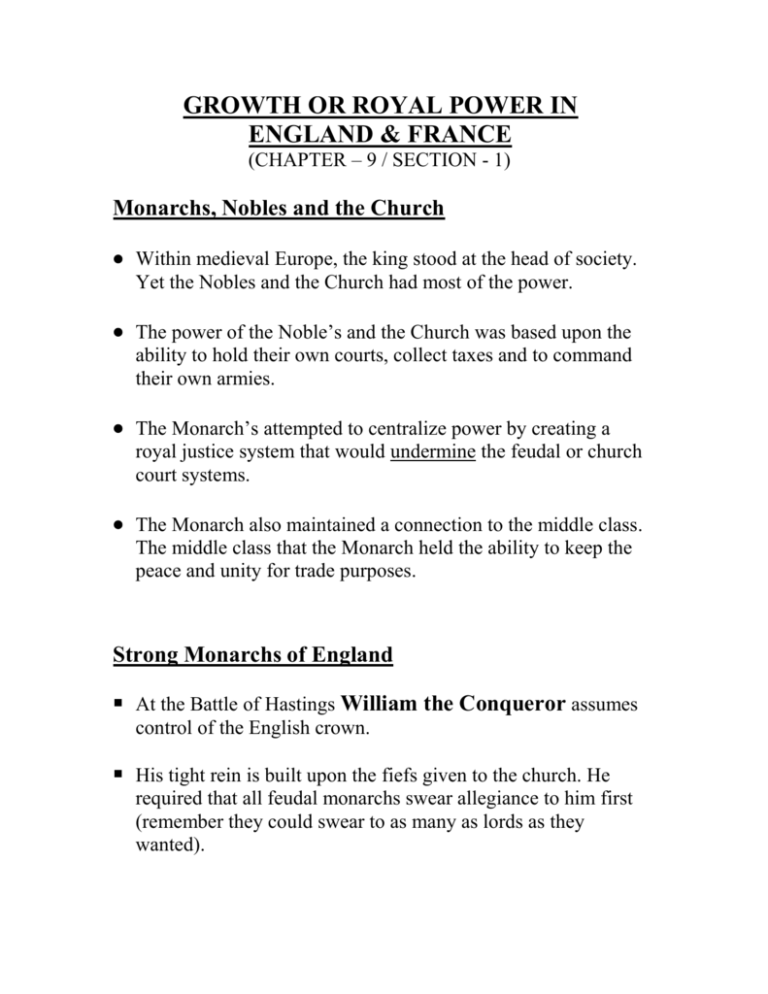
GROWTH OR ROYAL POWER IN ENGLAND & FRANCE (CHAPTER – 9 / SECTION - 1) Monarchs, Nobles and the Church Within medieval Europe, the king stood at the head of society. Yet the Nobles and the Church had most of the power. The power of the Noble’s and the Church was based upon the ability to hold their own courts, collect taxes and to command their own armies. The Monarch’s attempted to centralize power by creating a royal justice system that would undermine the feudal or church court systems. The Monarch also maintained a connection to the middle class. The middle class that the Monarch held the ability to keep the peace and unity for trade purposes. Strong Monarchs of England At the Battle of Hastings William the Conqueror assumes control of the English crown. His tight rein is built upon the fiefs given to the church. He required that all feudal monarchs swear allegiance to him first (remember they could swear to as many as lords as they wanted). To learn about his kingdom William had a census. Out of which he created the “Doomsday Book”. This census mapped out all of his land and what existed within it. Unable to change the customs William sent out justices to Enforce royal laws. The foundation of these courts became English common law (the law that is the same for all people). It was a legal system based on custom and law that applied to all of England. Henry II (1154) sets up an early jury system. Early on the juries would decide which cases could come forward for trial. Later, the jury evolved into 12 neighbors of an accused. Conflicts with the Church King Henry attempted to apply his court system into the Church by claiming the ability to try clergy. Thomas Becket, archbishop of Canterbury opposes the king’s move. Henry’s spoken rage of this discontent from Becket spilled over to his knights and in turn the knights murdered Becket in his church. To avert any problems with the church over this incident Henry eased his attempts to regulate the clergy. Thomas Becket was in turn declared a saint. Evolving Traditions of English Government King John (Henry’s son) was greedy, cruel and untrustworthy. There lay three powerful enemies, Pope Innocent III, one who led the Church at the height of its power within the Middle Ages. John’s battle with the Pope on a nominee was met with he being excommunicated and an interdict imposed upon the whole of England. To save his crown he placed all of England under the control of the papacy. King Philip of France battled King John and won the war, resulting in England’s loss of land now held under French rule. John’s very own nobles were upset with the tax system and the nobles forced John to sign the Magna Carta. Within this document the king was forced to affirm a list of feudal rights. The most import clause was the protection for every freeman from arbitrary arrest, imprisonment, except by “legal judgment of peers or by laws of the land”. This clause formed the basis of what is know as today as “due process of law”. Development of Parliament In 1295, King Edward I called upon the Great Council Which becomes Parliament) to approve money for a war with France. He creates the House of Lords (high nobles and clergy) and the House of Commons (knights and middle class). Over time Parliament would check the monarch’s attempt to limit the monarch’s power and their ability to impose taxes. Phillip Augustus strengthened his rule by not appointing vacant government positions with nobles, but with paid middle-class officials. He also granted charters to new towns, organized a standing army and introduced a new national tax. By the end of his reign in 1223 he had become the most powerful ruler in Europe. Louis IX the most admired French ruler of this time. He was noble, generous, charitable, devoted to justice and chivalry. To strengthen his rule he expanded the royal courts, ended serfdom and sent out officials to check on local officials. Just 30 years after his death he was declared a saint. Philip IV tried to collect taxes from the clergy setting off a clash with Pope Boniface VIII. The tax conflict escalated to where Philip tried to capture Pope Boniface. In a conflict Boniface died and a newly appointed French Pope moved the papal court to the city of Avignon, on the southern boarder of France. Estates General was established in 1302. This body had three representatives from all three estates, or classes. They were the clergy, the nobles and the townspeople. This did not develop as well as the English Parliament and never gained the power to balance royal power. THE HOLY ROMAN EMPIRE AND THE CHURCH (CHAPTER – 9 / SECTION - 2) A conflict builds between the monarchs and their quest to develop power and the church in its battle to maintain control over the lands. This struggle pitted Popes v. Holy Roman Emperors who ruled land from Germany, France and to Italy. The Holy Roman Empire In 936 A.D., Duke Otto of Saxony took the title of King of Germany. He worked closely with the church and helped defeat rebellious Roman nobles for the Pope. In return he was given the title of Holy Roman Emperor. The Duke was Holy-because he was crowned by the Pope and Roman-because they saw themselves as heirs to the thrown. Another conflict arose from whom would decide who would become Bishops or Abbots within their realm. The Cluny Reforms strengthened the church and the Popes tried to end such appointments. Conflict between Popes and Emperors Pope Gregory VII attempted to ban the practice of lay investiture; within this practice the lay person (a non-church person) would present bishops with a ring and staff to symbolize their office. The Pope believes that he should only that power. Emperor Henry IV felt that bishops held their lands as fiefs and that was their overlord. Pope Gregory VII excommunicated Henry IV, thus freeing up all of his subjects from allegiance to the Emperor. Faced with revolts at home Henry IV admits to the Pope that he is a repentant sinner. Henry IV later marched into Rome and forced the Pope into exile. Concordat of Worms ended the investiture struggle between the Pope and Henry IV to allow the church sole power to elect & invest bishops with sole spiritual authority. The Emperor had the right to invest them with fiefs. The Struggle for Italy Frederick I, called Barbarossa, wanted to build an empire from Baltic to the Adriatic Sea. Frederick was defeated by the Lombard League. However, he arranged a marriage with his son and the heiress (Constance). Their son Frederick II becomes the next Holy Roman Emperor. He spends very little time in Germany and pursues with clashes with the Popes and fails to subdue northern Italy. Effects on Germany & Italy Frederick II lack of interest allowed many German nobles to fragment the country into many feudal states. Germany would not achieve unity for another 600 years. Southern Italy and Sicily faced many centuries of attacks from the French and Spanish. The Height of Church Power Pope Innocent III felt a great power over Emperors and their subjects. He launches a brutal crusade or holy war against the Albigensians. The Albigensians wanted to purify the Church and return to the simple ways of early Christianity. Tens of thousands of Christians were slaughtered. EUROPEANS LOOK OUTWARD (CHAPTER – 9 / SECTION - 3) The World in 1050 A.D. Western Europe emerges and other thriving civilizations are beginning to test their strength around the world. Islam, reaching from Spain to India, spreads its knowledge, goods and ideas. India’s Hindu and Buddhists traditions flourish as well as mathematics (number system created). China passed along new technologies with the invention of paper, printing and gun power. The use of coins and paper money within trade was unknown to medieval Europeans. In Mexico and Central America the Native Americans built great temples, works of art, pottery, textiles and jewelry. However, were not in contact with the Europeans. The Byzantine Empire still studied Greek and Roman writings and remained prosperous and united, unlike that of Western Europe. The Seljuk Turks had by 1071 invaded and conquered most of the Byzantine Empire. They had converted to Islam. Their power extended over into Palestine and Central Asia. The Crusades As the Seljuk threat grew within the region, Byzantine Emperor, Alexis I, asked Pope Urban II for help. The Council of Clermont was a plea from Pope Urban II for bishops and nobles to come to the free the holy land (Jerusalem) from invaders. Many of knights went off to battle and few would return. Most of the crusaders left to acquire wealth and land and some to escape trouble at home. Another motive was to heal the schism or split between the Roman and Byzantine churches. For over 200 years crusaders battled to free Palestine. Only the first crusade came close to realizing its goal. Jerusalem was held by both the Muslims and the Christians. Impact of the Crusades Both sides failed to permanently conquer the Holy Land. The crusades create the legacy of hatred between Muslim and Christians. Economic changes were led by the increase in trade. The crusaders brought back goods to trade and were able to do so because of the increase in the navel fleet needed to transport the armies The monarchs increased their power by winning new rights to levy or collect taxes in order to support the crusades The Church gained power through the enthusiasm of crusades. Bitter clashes still existed between the Pope and the monarch’s and the split between the Byzantine Churches and Rome did not heal, especially after the fourth crusade. Marco Polo brought back stories about China and its greatness. Europeans could not accept the wonders he claimed and called him a lair. However, crusaders and explorers, like Polo, created a desire to trade with the Far East. The Reconquista in Spain The war between Muslims and Spaniards had raged for hundred of years. The drive to remove the Muslims from Spain was known as the Reconquista. However, the Muslims still had a strong influence in Granada. Isabella and Ferdinand made a final push to rid Spain of the Muslims. Under Muslim rule Spain had enjoyed religious toleration of Christians, Jews and Muslims. Isabella ended this age of toleration by starting the Inquisition. This is where the Church court set up to try people of accused heresy. Due to this practice 150,000 Jews and Muslims (well educated & skilled people) flee Spain. The Inquisition crushed Spain’s economy. LEARNING, LITERATURE, & THE ARTS (CHAPTER – 9 / SECTION - 4) Medieval Universities To maintain the economic and political improvements within the Middle Ages there came the need to improve upon the educational institutions. The Church in particular wanted to enhance the clergy’s education so they could help within the bureaucracies. Academic Guilds Schools began to emerge around the 1100’s. Most were located around some of the great cathedrals. These cathedral schools would later evolve into universities. These universities were organized like Guilds with charters that would protect the rights of the members and also set standards for training. Student Life A school day would begin around 5:00 a.m. with a morning prayer. Classes would then continue until around 10:00 a.m. Shortly after they would resume class and end about 5:00 p.m. Most classes were rented rooms and the students had to sit on hard wooden benches. Teachers would dictate for hours their lessons and the students were expected to memorize all that they heard. To show that they had mastered a subject the students would take an oral exam. To earn a B.A. it would take 3 – 6 years and a M.A. several more years of school. Women & Learning Women were not allowed to attend the universities. This exclusion seriously affected their lives. They were deprived any mental stimulation from the life within a university. Philosophy Greek and Christian writings were adverse to each other. Aristotle taught that people should use reason to discover basic truths Christians accepted many ideas on faith. That the church was the final authority on all questions. Christian scholastics tried to resolve the conflict by using a method known as Scholasticism. This is the use of reason to support the Christian beliefs. Thomas Aquinas, monumental work “Summa Theologica” examined Christian teaching in light of reason. He concluded that faith and reason existed in harmony and that both led to that God ruled the orderly universe. Science and Mathematics In science little progress was made due to the fact that scholars still felt that all true knowledge must fit with the Church teachings. Medieval Literature Even though Latin was the language of scholars and churchmen, new writings were beginning to appear in the vernacular. Vernacular is the use of everyday ordinary languages such as French, German and Italian. Medieval literature included epics, or the long narrative poems about feudal warriors and also common people. Dante’s Divine Comedy Dante Alighieri writes an imaginary poem, the Divine Comedy, about a journey into hell where souls await forgiveness. Poem of the Cid describes battle between the Muslims and the bold Christian lord, who battled Muslims in Spain. The Canterbury Tales, by Geoffrey Chaucer. Within his tale he depicts the characters telling a story about medieval life. Architecture and Art The style of the churches reflected a Roman style to them. They often had thick walls and towers. Giving the appearance of fortresses. Builders began to use an architecture style known as flying buttresses or stone supports. These types of supports allowed builders to construct higher walls and leave space for large stain glass windows. The art within the stone and glass windows were to portray scenes from the bible and other religious themes. Illumination is the artful decoration of books. This introduction of bright colors and intricate designs and miniature paintings of biblical scenes and daily life helped one to understand the daily life of people in various levels of society and the tasks involved in their lives. A TIME OF CRISIS (CHAPTER – 9 / SECTION - 5) The Black Death How a shipment of grain from the Black Sea port of Caffa to Sicily brought one of the worst plagues to hit Europe. From Italy to Spain and France to the rest of Europe this plague killed one in three people. Most would die within days. The Bubonic plague spread from fleas on rats to people that traveled around the world in trading. Social Upheaval With no know cure for the disease people turned to various ways to combat the plague. Magic, witchcraft and other means were used to try and stop from getting the disease. Others saw it is as a punishment from God and would whip themselves to show repentance. Economic Effects In the late 1300’s the plague took its toll on the several economic levels. With less of a work force the production of goods dropped. Surviving workers demanded higher wages, thus driving up the price of goods creating inflation. Landowners switched to less labor intensive produce (raising animal’s raising v. crops) and Merchants stopped taking in people into Gilds. Both seeking wage controls. Revolts broke out all across Europe and the continent would not recover from the effects of the plague for more than a 100 years. Upheaval in the Church The people asked this question to the spiritual leaders “why were some spared and others were to die?” (What is the reaction of the leaders in this time of crisis?) Pope Clement V moved the papal court into France and for the next 70 years it remained under French domination under what was known as the Babylonian Captivity. The lavish lifestyle of the Pope and his people during this time had many question the legitimacy of the papacy. Thus in 1378 reformers elected their own pope in Rome and then the French elected in turn their own pope. All groups claimed their pope to be the “vicar of Christ”. New Heresies With a weak and corrupt Church within this time opened up challenges from two popular preachers, John Wycliffe of England and Jan Hus of Bohemia. Both called for reforms and preached ideas contrary to those of the Church. Wycliffe had his students translate the bible into English so the people could read it v. a clergy member. Hus was found guilty and burned at the stake for his heresy. Hundred Years’ War National pride and control of lands prompted England and France to wage war. Between 1337 and 1453 a series of conflicts were fought. Early English victories were attributed to the use of the longbow. The longbow could fire three times as many arrows than the old crossbow and could pierce many of the armor of the time. English victory seemed to be at hand. Joan of Arc A 17 year old peasant girl approached the uncrowned King of France and requested to lead his troops against the English. The renewed spirit of the French troops brought about several victories. However, she was taken captive by English allies. In turn the English tried to discredit her by trying her for witchcraft. Found guilty she was burned at the stake. Years later the Church reversed the conviction and declared her a saint. Effects of the War On the French side there emerged a strong sense of Nationalism. This in turn allowed French Kings to assume more power. The English lost European lands and their dreams of a continental empire. However, soon English rulers would turn their interest toward new trading ventures overseas. The invention of the longbow and cannon undermined the importance of castles and mounted knights (How?). Also the need for large standing armies v. feudal vassals was the new trend to war. With the end of the Black Death trade populations grew and manufacturing began to recover. Trade began to develop across the world once more. New inventions would give rise to further changes within the Renaissance, Reformation and the Age of Exploration.
